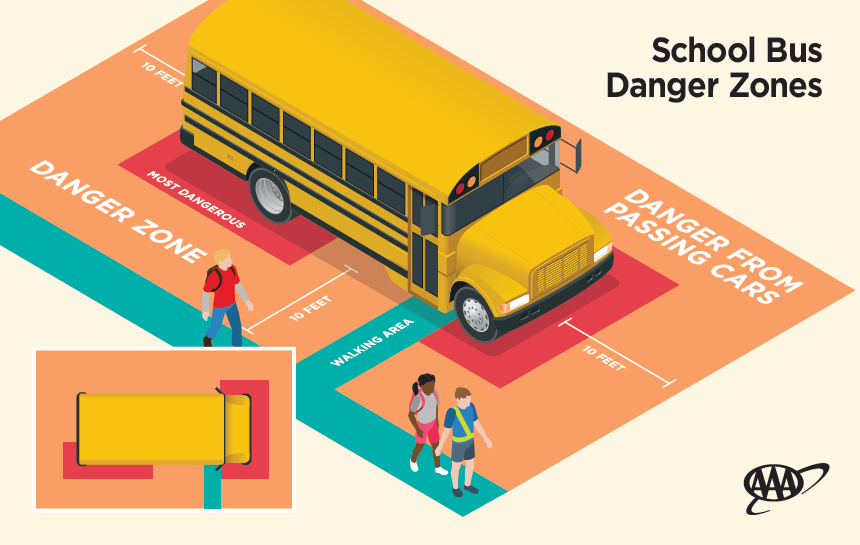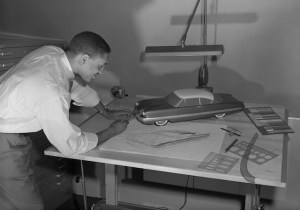The yellow school bus is emblematic of the American public school systems, but everyone plays a part in maintaining kids’ safety from bus stop to drop off.
There were 111 fatalities in school transportation vehicles from 2013 to 2022, according to the most recent report from the National Highway Traffic Safety Administration, 50 of which were drivers and 61 passengers. It is imperative for both parents and fellow drivers to understand the specific rules, regulations and facts about school buses to ensure every child arrives to school and back home safe.
Here, we’ve explained some of the most common questions regarding school buses, from why they’re yellow to when it’s OK to pass and when it’s definitely not.
When do you have to stop for a school bus?
One of the most critical aspects of school bus safety is understanding when to stop. If driving behind or approaching a school bus with flashing red lights, you must come to a complete stop. In most states, this includes stopping on both sides of a divided roadway unless there is a physical barrier or median separating the lanes. New York law requires drivers to stop for a school bus on a divided highway even if there is a barrier. Failing to stop for a school bus can result in hefty fines and, more importantly, poses a severe risk to students’ safety.

Can you pass a school bus with flashing yellow lights?
Flashing yellow lights on a school bus indicate that it’s preparing to stop. In most cases, you are not required to stop when you see these yellow lights, but you should exercise caution. Slow down and prepare to stop as the transition from yellow to red lights signals the loading or unloading of students.
Is it illegal to pass a school bus?
Passing a school bus when its red lights are flashing and the stop sign is extended is illegal in every state. This law is in place to protect the safety of students getting on or off the bus, and penalties for disregarding can be severe, including fines and even license suspension.
A growing number of states, including Rhode Island, Connecticut and New York allow stop-arm cameras on school buses to crack down on illegal passing.
Why don’t school buses have seat belts?
School buses are designed with a safety concept called compartmentalization which uses high, padded seatbacks and closely spaced seats to protect passengers in the event of a collision. By creating a protective cocoon-like structure, the unique design is effective in minimizing injuries and is why seat belts are commonly not found on school buses.
Why do school buses stop at railroad tracks?
After a 1938 crash in Utah that killed 25 children and the driver, national laws were put in place to prevent such a tragedy from ever happening again. Now, bus drivers are required to open the bus door, look around and listen intently for approaching trains to make sure there is no imminent danger before proceeding. This practice ensures that students and the bus itself are not in harm’s way when crossing railroad tracks, reducing the risk of accidents.
Why are school buses yellow?
The iconic yellow color of school buses unsurprisingly serves a practical purpose – visibility. Yellow is a highly visible color that stands out in various weather conditions and lighting, making it easier for other drivers to spot school buses from a distance. This enhanced visibility plays a significant role in preventing accidents and making sure students are as safe as possible.
How do you feel about school bus safety? Do you think more states should allow stop-arm cameras on school buses to help control illegal passing? Tell us in the comments.
21 Thoughts on “When to Stop for a School Bus and More School Bus Safety Questions”
Leave A Comment
Comments are subject to moderation and may or may not be published at the editor’s discretion. Only comments that are relevant to the article and add value to the Your AAA community will be considered. Comments may be edited for clarity and length.


















All states have school buses.All children who ride deserve safety . ALL SCHOOL BUSES NEED S.A.C. Especially now that nonreaders of the PRINTED word are greater in number than ever before in USA . MAKE the LAW ..ENFORCE THE LAW TO THE LETTER.
Charge those who break the law DOUBLE the cost of the camera and the installation. Increase the fine for each infraction of the law .NO WARNINGS !!!! Penalize immediately. NO child is given a 2nd chance once its life is snuffed out or it is maimed for life .
It’s all about collecting revenue. Stopping on a divided roadway ? Ever see anyone, anywhere climb over a road divider ?
I think it’s an no brainer – stop arm cameras should be on ALL buses. It seems the question is why would a bus not have a stop arm camera on it.
Yes, all states should be required to have cameras on the Stop sign that extends from the bus. People need to be held accountable. Every September you see news on TV of cars flying by a stopped school bus. Not good.
I drive a school bus for a living in the state of Rhode Island. The highly-standardized design of a school bus body, and the strict training we receive makes it the safest way to get to school and home. Of course, not every driver is the same, but most that I have met have the safety of the children as their number one priority. I have found, on the busy roads of the city of Cranston, R.I., most people will stop when they see any flashing lights on my bus. (Even the amber lights.) Unfortunately, at least once a day, someone will pass my reds and stop sign. I believe half simply do not know. An article like this one being made into a public service announcement might help.
Thanks for the fine article.
I am a school bus driver in RI. I can’t begin to tell you the awful things that happen EVERY DAY!! It is up to me to protect our children,your children, grandchildren and your neighbors children!! OK so no one wants to stuck behind a school bus,I get that, but seriously??? Cant you be aware of and concerned for the CHILDREN??!. Even the police dont stop offenders, I’ve seen them behind me, or doing radar or even in opposing traffic, and they do not pursue offenders. They are even at the high school and still don’t stop students or traffic from going through bus reds!! My opinion is that it only takes a few tickets to make more people aware, because word spreads fast about what a BIG $$ ticket offence this is. Not to mention that it helps community safety and adds to the community coffers!!
I’ve been stuck behind school buses and it’s maddening! You would think an advanced society like ours would have developed a better system for safely transporting kids to and from school. There’s no reason why the bus driver can’t pull over and let the cars behind him go by before he turns on his flashing red lights. I’ve been in school bus traffic in which both the cars in front of me and the ones behind me were backed up as far as I could see, as much as half a mile! It’s insane to have every car in line forced to follow a school bus at a snail’s pace and have to make every stop the bus makes, sometimes as little as 200 feet apart. I don’t blame the occasional person who gets frustrated and is tempted to pass. Adults have places to go, many times under time constraints whereas kids going home from school can wait a few extra minutes to get home.
Bus routes are set routes. Why not change yours ?
Kids have places to go..safely into a school and into a house.
Stop-arm cameras would be very useful in cutting down on passing. This happens all too frequently. It would be necessary for there to be follow through on the violators.
All school buses should have stop arm cameras to catch the people who think the law doesn’t apply to them, that said, there must be a system to enforce the law.
If a school bus is stopped, but not on the roadway, but on the shoulder, by law are you still required to STOP WITH FLASHING RED LIGHTS ?
When I lived in Carlisle, Massachusetts, back in the 1980s, I noticed a change in school bus stopping behavior. It was a brilliant solution to the risk of cars passing a stopped school bus. I don’t know if this technique was instigated by one or more of the drivers, or if was a town policy, or if they’re still doing it today. I have not seen it in any of the Massachusetts towns where I’ve lived in the decades since.
Here’s the technique: All the roads in Carlisle are two-lane. When the bus makes a stop, the driver swerves the nose of the bus over into the oncoming lane, so the bus is diagonally across the two-lane road, blocking BOTH lanes and making it impossible for anyone to pass in either direction. When the kids are safely dispatched on or off, the bus straightens out and proceeds on its way. Very simple, and 100% effective.
While I’m all about privacy, cameras on a schoolbus to keep the kids safe is a no brainer.
If a school bus with flashing red lights is stopped at a perpendicular cross street but within 500′ of the intersection should traffic on the main road stop?
I think the graphic provided with this article is not sufficient to illustrate even the most basic rules of the road. It doesn’t show stopping distances and doesn’t show traffic from both directions. This is a serious subject and deserves more than a cursory graphic dropped in.
All States should require cameras on school bus stop arms.
If I am (in NY) behind a stopped school bus that has its red lights flashing & extended stop sign, & the kid(s) are obviously already on the bus, and the only reason that the bus is still there is because a mother is standing at the curb chatting with the bus driver, am I required to wait until they finish their conversation before proceeding? I run into this a lot in the morning when I’m on my way to work.
School bus rules are critical for child and driver safety and also other drivers.
Failing to stop or passing illegally should be a moving violation in every state and emphasis should be placed on school bus rules for written and actual driver tests before getting a license or license reinstatement. REMEMBER were all kids once and many of us road school busses!!!
If the road is a four lane one ( two each way ) and there is a island divider in the middle ( or not ) and a school bus is stopped in the opposite direction with the red lights on, are the drivers in the opposite direction legally forced to stop ?
Hi Tom, great question! The laws vary by state, but most require drivers to stop on both sides of a divided roadway unless there is a physical barrier or median separating the lanes. In New York, drivers must stop even if there is a barrier. I hope that helps!
So in Queens, New York, along Queens Blvd. which has 4 separated sections with barriers and fences separating the sections, and a total of 10 lanes of traffic, a school bus in the opposite direction, which is in excess of 100+ feet distance away , one must stop? ! How is one going to see the school bus in the opposite direction across so many lanes of traffic?
Marisa, there is no barrier involved, the bus is just off to the side, but not fully on the roadway.